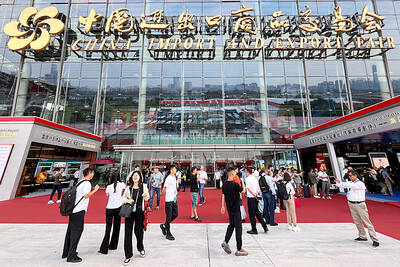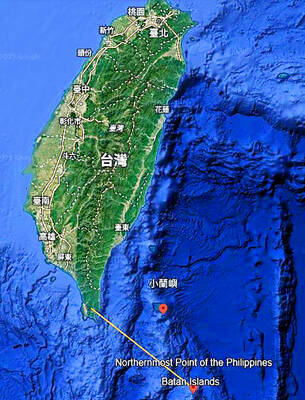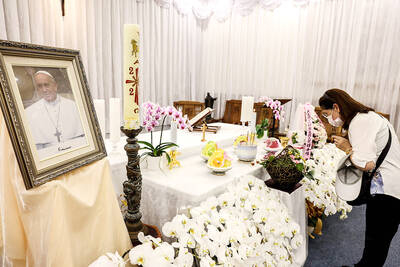With massive white concrete pylons rising from a small farming valley, the New Tomei Expressway is emerging as Japan's answer to Germany's autobahn.
Engineers are attacking mountains, straightening curves, smoothing inclines, and placing 60 percent of the highway on bridges or in tunnels, all in an effort to allow drivers to speed along at 140kph.
The problem is, in 21st-century Japan, building new highways has the air of looking at the world through a rear-view mirror.
With Florida-style demographics and a European-type rail network, it is unlikely that hordes of aging Japanese are going to jump behind the wheel for a high-speed cruise. Since 1990, vehicle sales here have dropped by nearly a quarter.
"It is absolutely, 100 percent unnecessary," said Hideki Kato, president of Japan Initiative, a Tokyo research agency.
So, as construction advances at a cost of US$1 million for every 5.5m, this six-lane luxury highway may stand as a monument to Japan's late-20th-century addiction to concrete.
Highway construction here once enjoyed wide popular support as a way to spread Tokyo's wealth and to reduce rural isolation and poverty in this California-sized nation. But in recent years, road construction projects have taken on the air of government make-work programs, intended to disguise Japan's growing unemployment.
In fact, Japan has spent trillions of dollars in the 1990s in an effort to build its way back to economic growth. But instead it finds itself deep in recession and saddled with daunting construction bills -- the world's largest government debt and an annual deficit that increased fivefold in the last decade.
the `construction state'
In Japan's new budget, Prime Minister Junichiro Koizumi has succeeded in cutting highway spending, using money saved to seed future growth computers in schools, job training for laid-off workers and child care to allow women who are now at home to join the paid work force.
A recent Nihon Keizai Shimbun poll showed that 77 percent of Japanese citizens, tired of the "construction state," supported the prime minister's effort to privatize the Japan Highway Public Corporation, the nation's major road builder.
"Those who are asking the government to build expressways are limited to the heads of local governments and presidents of construction companies," Nobuteru Ishihara, minister for administrative and regulatory reforms, said to applause at one of 50 government-sponsored town meetings conducted around Japan last fall.
Still, those are powerful government bureaucracies and private lobbyists, whose voices, along with rural constituents, have carried clout with the governing Liberal Democrats throughout their half-century in power.
One conspicuous no-show at the town meetings was Chikage Ogi, Japan's construction minister. At her ministry, employees still sing the Utopia Song, an agency anthem that rhapsodizes about "asphalt blanketing the mountains and valleys."
Pro-construction politicians, known as the "road tribe," have been resisting the budget cuts. All three research councils of the Liberal Democratic Party want to keep in place a plan to spend US$160 billion over the coming years to increase Japan's 6954km expressway network by two-thirds.
This is so even though truck traffic along the old Tomei expressway has actually declined since 1995, with the erosion of Japan's manufacturing base.
The New Tomei will double the number of lanes along the same route.
"In all the prefectures, all of the Diet members and all the governors are very enthusiastically supporting construction of the second Tomei," said Tadatsune Kajimoto, director of a new industrial park, where he noted that companies, in anticipation of the new roadway, had already moved in. "If the government doesn't keep its promises, it is very irresponsible."
Ryotaro Nishigaya, an orange grower here, agreed, saying, "Talk about freezing construction is outrageous." The father of four adult children, he predicted that driving would increase in Japan, saying, "Each household could have three to five cars."
Others said traffic would increase if the government cut tolls, currently US$30 for the 219km drive from here to Tokyo's western suburbs.
Still, critics say, Japan is littered with public works projects built with little concern about financing. From heroes of development, construction company presidents have became villains of economic stagnation, and are accused today of building bridges and bullet trains to nowhere.
"We are starting to look like medieval Spain, wasting our money on useless things," grumbled Hideaki Mizuno, an investment banker in Tokyo. "We need to use market mechanisms to allocate money."
`dogs and demons'
That would be a change from the recent past. During the 1990s, construction employment increased by 17 percent, while construction investment fell by 12.5 percent, according to a study by the Research Institute of Construction and Economy, a private Tokyo research group.
Alex Kerr, author of Dogs and Demons, Tales from the Dark Side of Japan (Hill and Wang, 2001), writes that Japan will spend "three to four times more than what the United States, with 20 times the land area and more than double Japan's population, will spend on public construction in the same period."
He cited statistics indicating that Japan pours about 30 times as much concrete per square meter as the United States.
"There are politicians who need the construction industry, for money and votes,"said Taro Kono, a member of parliament whose suburban district west of Tokyo is crossed by the existing Tomei expressway.
Kono said he was one of only two Liberal Democratic members opposed to the New Tomei. Of 243 party members in the lower house, he said, the only other opponent "is the prime minister."
Despite the public support he enjoys, Koizumi managed only mixed results in his recent showdown with parliament over highway spending.
In the 2002 budget, he succeeded in abolishing the government's annual direct payment to the Highway Corporation, US$2.3 billion last year, and cutting public works spending by 10.7 percent, as part of a plan to reduce it by one-quarter over the next five years.
But the prime minister did not win backing for a 30-year limit on repaying the Highway Corporation's debt, which would have ended much new highway construction, including the New Tomei. Estimates of the corporation's debt range from US$150 billion to US$220 billion.
A panel is to be appointed to set a deadline and a method for privatizing the corporation and three other public road-building corporations.
Skeptics call this a defeat for Koizumi. Others say this was the path taken 15 years ago with the successful privatization of Japan National Railways.

SECURITY: As China is ‘reshaping’ Hong Kong’s population, Taiwan must raise the eligibility threshold for applications from Hong Kongers, Chiu Chui-cheng said When Hong Kong and Macau citizens apply for residency in Taiwan, it would be under a new category that includes a “national security observation period,” Mainland Affairs Council (MAC) Minister Chiu Chui-cheng (邱垂正) said yesterday. President William Lai (賴清德) on March 13 announced 17 strategies to counter China’s aggression toward Taiwan, including incorporating national security considerations into the review process for residency applications from Hong Kong and Macau citizens. The situation in Hong Kong is constantly changing, Chiu said to media yesterday on the sidelines of the Taipei Technology Run hosted by the Taipei Neihu Technology Park Development Association. With

CARROT AND STICK: While unrelenting in its military threats, China attracted nearly 40,000 Taiwanese to over 400 business events last year Nearly 40,000 Taiwanese last year joined industry events in China, such as conferences and trade fairs, supported by the Chinese government, a study showed yesterday, as Beijing ramps up a charm offensive toward Taipei alongside military pressure. China has long taken a carrot-and-stick approach to Taiwan, threatening it with the prospect of military action while reaching out to those it believes are amenable to Beijing’s point of view. Taiwanese security officials are wary of what they see as Beijing’s influence campaigns to sway public opinion after Taipei and Beijing gradually resumed travel links halted by the COVID-19 pandemic, but the scale of

A US Marine Corps regiment equipped with Naval Strike Missiles (NSM) is set to participate in the upcoming Balikatan 25 exercise in the Luzon Strait, marking the system’s first-ever deployment in the Philippines. US and Philippine officials have separately confirmed that the Navy Marine Expeditionary Ship Interdiction System (NMESIS) — the mobile launch platform for the Naval Strike Missile — would take part in the joint exercise. The missiles are being deployed to “a strategic first island chain chokepoint” in the waters between Taiwan proper and the Philippines, US-based Naval News reported. “The Luzon Strait and Bashi Channel represent a critical access

Pope Francis is be laid to rest on Saturday after lying in state for three days in St Peter’s Basilica, where the faithful are expected to flock to pay their respects to history’s first Latin American pontiff. The cardinals met yesterday in the Vatican’s synod hall to chart the next steps before a conclave begins to choose Francis’ successor, as condolences poured in from around the world. According to current norms, the conclave must begin between May 5 and 10. The cardinals set the funeral for Saturday at 10am in St Peter’s Square, to be celebrated by the dean of the College